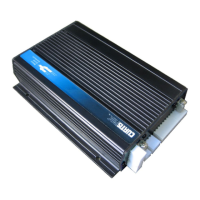Power Connection
The Battery is connected to to 1310 power tabs though a fuse and a key switch. The power tabs
are used because there are inductive loads on the system (Aux Contactor and Proportional Value
coils) and the current could exceed 3amps. The fuse is required to protect the wiring as the 1310
could draw significant power if there were a short or failure in the unit.
The key switch is used to “start” the system. Both the B+ High Power Tab and the B+ signal at
J1-24 are used as the Key Switch Input. When the key switch is closed, the B+/ KSI input goes
high, the 1310 power supply brings up the 1310 and the BDI functions are enabled.
Outputs
The system shown has 2 high power outputs and 2 LEDs, that run of key switch power.
Using the PWM outputs to drive the LEDs allows the the brightness of the LEDs to be varied.
The frequency is too high for the human eye to see any flickering. Note that a dropping resistor
must be used because even low duty cycle PWM applies full battery voltage is short bursts, and
this will destroy the LED without a dropping resistor limiting the current. Note the internal
impedance to ground of the driver will cause leakage current to flow through the LEDs even
when the output driver is off. Refer to Digital Output Specifications following when calculating
this leakage current. This leakage current can be enough (> 2 ma) to light high efficiency LEDs.
Model 1310-5210 provides two output drivers (Outputs 14 and 15) that do not have leakage
current issues and may therefore be the best suited for driving LEDs.
The first power output drives a proportional valve coil. Outputs 1 and 2 are special in that they
have internal current feedback lines. VCL can use this signal in a PID loop to regulate current,
which is necessary to properly control the position (and flow) in a proportional valve. Outputs 1
through 4 also run at a higher frequency and thus can provide a smoother current (less ripple).
The second power output drives a basic contactor coil. It is connected to output 2, which has a
current feedback signal. In this case, the VCL can use the current feedback signal to ensure that
the coil is connected and drawing the proper current when on. In this way, enhanced fault
diagnostic can be performed.
Switch Inputs
All of the Outputs can be used as active high inputs (“on” when connected to B+). There are 4
special inputs that are active low (“on” when connected to B-). If an Output is being used as an
input (such as is the case on Input/Output 15) the VCL must take care not to turn on that output
or a direct short to B+ could be established through the switch and the internal FET driver.
1310 Vehicle Control System Users Manual Release Rev B Page 14 of 51

